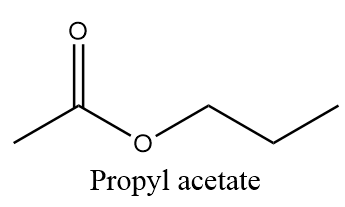
Propyl acetate, ${C_5}{H_{10}}{O_2}$ gives the odour and taste to pears. How many moles of $C$ are present in $1.50$ moles of propyl acetate?
Answer
398.4k+ views
Hint: For one mole of a compound, the number of moles of an element in that compound is equivalent to the number of atoms of that element present. For example, in the mole of methane i.e., $C{H_4}$the number of moles of carbon atom and hydrogen atom will be equivalent to $1$ and $4$ moles respectively.
Complete answer:
Propyl acetate is an example of ester and due to its sweet smell and taste, it gives the odour and taste to pears and is also used in fragrances and as additive flavours. The molecular formula of propyl acetate is ${C_5}{H_{10}}{O_2}$ and structurally it is represented as follows:

Now, as per question, we need to find out the number of moles of carbon present in $1.50$ moles of propyl acetate. So, the calculation is done in the following way:
Number of moles of carbon in $1$ mole of ${C_5}{H_{10}}{O_2} \Rightarrow 5$moles
Therefore, the number of moles of carbon in $1.50$ moles of ${C_5}{H_{10}}{O_2} \Rightarrow 5 \times 1.50 = 7.5$ moles.
Hence, $7.5$ moles of $C$ are present in $1.50$ moles of propyl acetate.
Note:
Ensure not to get confused between the mass percentage of an element and the number of moles of an element in a compound. The mass percentage of an element in a compound is equal to the ratio of actual amount of that element (i.e., the number of atoms of the element present multiplied by its molar mass) to the molar mass of the compound multiplied by $100$ whereas the number of moles of an atom is equivalent to stoichiometric ratio in which it is present.
Complete answer:
Propyl acetate is an example of ester and due to its sweet smell and taste, it gives the odour and taste to pears and is also used in fragrances and as additive flavours. The molecular formula of propyl acetate is ${C_5}{H_{10}}{O_2}$ and structurally it is represented as follows:

Now, as per question, we need to find out the number of moles of carbon present in $1.50$ moles of propyl acetate. So, the calculation is done in the following way:
Number of moles of carbon in $1$ mole of ${C_5}{H_{10}}{O_2} \Rightarrow 5$moles
Therefore, the number of moles of carbon in $1.50$ moles of ${C_5}{H_{10}}{O_2} \Rightarrow 5 \times 1.50 = 7.5$ moles.
Hence, $7.5$ moles of $C$ are present in $1.50$ moles of propyl acetate.
Note:
Ensure not to get confused between the mass percentage of an element and the number of moles of an element in a compound. The mass percentage of an element in a compound is equal to the ratio of actual amount of that element (i.e., the number of atoms of the element present multiplied by its molar mass) to the molar mass of the compound multiplied by $100$ whereas the number of moles of an atom is equivalent to stoichiometric ratio in which it is present.
Recently Updated Pages
Can anyone list 10 advantages and disadvantages of friction

What are the Components of Financial System?

How do you arrange NH4 + BF3 H2O C2H2 in increasing class 11 chemistry CBSE

Is H mCT and q mCT the same thing If so which is more class 11 chemistry CBSE

What are the possible quantum number for the last outermost class 11 chemistry CBSE

Is C2 paramagnetic or diamagnetic class 11 chemistry CBSE

Trending doubts
The correct order of melting point of 14th group elements class 11 chemistry CBSE

One Metric ton is equal to kg A 10000 B 1000 C 100 class 11 physics CBSE

What is the specific heat capacity of ice water and class 11 physics CBSE

Define least count of vernier callipers How do you class 11 physics CBSE

What is the chemical name of Iron class 11 chemistry CBSE

The dimensional formula of dielectric strength A M1L1T2Q class 11 physics CBSE




